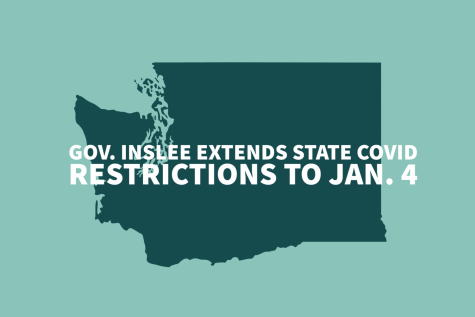Pierce faculty persist through the online transition

Math professor Judy Petkovsek endured her first quarter of online classes at Pierce College.
Petkovsek taught one online class in previous quarters at Tacoma Community College, which gave her familiarity with online courses. However, in preparation for the spring quarter, she remained concerned for the students who believed that math could only be learned in a classroom. “My biggest fear was teaching online to students who didn’t want to take online courses,” Petkovsek said.
In April, all Pierce College classes moved online. The spring quarter of 2020 marked the first time that many teachers experienced online classes, which required faculty to adapt to a mandatory virtual environment. With Canvas, teachers could reach students through an established platform that allowed for a smooth transition online.
Petkovsek is one of many professors at Pierce College who had to adjust to teaching students virtually, rather than in person. With online classes being mandatory, the amount of productivity and self-motivation of students may be in question.
“I was teaching students who signed up for online classes, and they knew what they were getting into; they knew they had to be self-motivated, and they knew they had to work hard at this on their own.”
Petkovsek noticed a small drop in the productivity amongst her students, however, but more so in the likeness and reason for taking her class. For her Math and Society class, she witnessed a drop in productivity due to the sense that this would be her student’s only math class taken while at Pierce.
On the other hand, her Precalculus II students’ productivity either stayed the same as previous grounded classes or rose. Petkovsek mentions that these students are going into the STEM field, which requires a higher level of mathematics. “They seemed really motivated and very self-driven,” Petkovsek said. “I gave them a little bit of support, and they go and take it very far.”
English professor Kayla Pohl taught English 101 for the first time online this quarter. According to Pohl, she had experience with teaching online classes in the past, but worried for the students who may not have the resources to transition to online.
“When you just switch everyone to online, the issue is that there are already so many inequities among Pierce college students,” she said. “There are racial inequities and financial inequities, so you have some students that just don’t have the resources to be able to do online learning.”
Virtual streaming platforms such as Zoom played a vital role in the ability to speak with students in real-time. The use of the service was not required by Pierce College, as teachers had the opportunity to host asynchronous or synchronous classes. This gave more flexibility with class schedules and allowed students to complete schoolwork outside the designated class hour.
To better serve these inequities and adapt to a virtual platform, Pohl had to change her curriculum by conforming to daily lesson plans. “Every quarter, I change a little bit based on feedback from students,” she said. “But this quarter especially was about cutting down anything unnecessary or anything that just doesn’t work well in an online format.”
Changing the format of her lesson plan meant less time to teach topics that would have required longer than a small fraction of class time. “Research says that you have to keep videos as short as possible, no more than like five or ten minutes,” she said. “I mean eventually you’re going to get down to trying to deliver content in a Tik Tok format. How am I going to translate Rhetorical Theory to a quick five-minute conversation? Not easy.”
Pohl devoted time to discussions and group activities in grounded classes, but online classes have made it harder to replicate that in an online environment. According to Pohl, an asynchronous classroom is best for an online format, where people with jobs or other outside devotions have more flexibility in the classroom.
Yet, this quarter, she and Petkovsek noticed a small decrease in student productivity. Despite some of the difficulties professors face, many remain optimistic and determined to see this quarter through.
To help ensure productivity and connections with her students, Petkovsek used Zoom to record lectures in real-time and required weekly attendance phone calls. Petkovsek saw weekly phone calls as an opportunity to connect with students and solve any difficulties with the class.
“I check in with them once a week for what obstacles they’re having, that week or any struggles they’re having for the week,” she said. “I check in on their grades and, if I see a grade that is low or if they missed our homework assignment, I talk to them about it.”
Likewise, Pohl also contacted her students, who may have been falling behind. “I can’t get in contact with those students like I normally could,” she said. “I’ve been emailing and messaging in Canvas as much as possible to try to reach out to these students and tell them; it’s okay if you miss an assignment, turn it in late, just don’t stop; try to keep going.”
Along with communicating outside of class, allowing students to access daily Zoom recordings at any time of the day gave Petkovsek’s students more flexibility. The Zoom meetings could be watched multiple times a day, unlike a grounded classroom. According to Petkovsek, classroom interactions were still important, even though it is more difficult in a Zoom meeting.
“I tried to make it as much of a classroom experience as possible before class starts,” she said. “I try to do small talk, like, ‘How was your weekend? What’s going on?’ I get students to kind of get to know each other, and I get to know my students.”
According to Petkovsek, using Zoom for the first time online at Pierce, brought forth difficulties with the storage and memory of the recorded videos. Many teachers experienced challenges with the limits to a non-professional Zoom account that restricted meetings to 40 minutes long. But with help from Pierce College’s E-Learning Center, the transition was smoother. “It’s been nice because we’ve gotten a lot of those bumps and bruises kind of work through so that didn’t happen the next quarter; it all kind of goes a little smoother.”
During either a grounded or online class, asynchronous or synchronous, Pohl pointed to the reason she enjoys teaching English at Pierce. “Just coaching students so they can say the things they want to say and participate in the communities that they want to participate in.”
With a quarter of online classes coming to a close, Pierce College faculty adjusted to a virtual environment on short notice. They gave students the ability to succeed at home and worked diligently to connect with students outside of class. Going forward, Pierce has an improved understanding of online courses and prepares for possibly two more quarters of social distancing.





